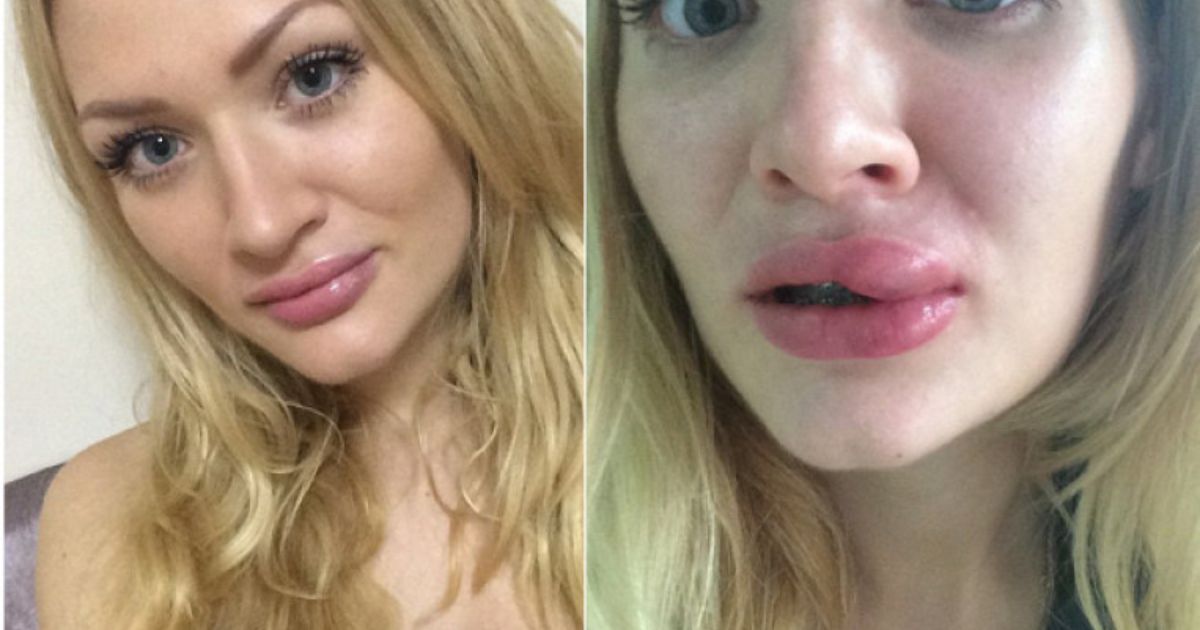“Lip filler gone wrong” refers to instances where the results of lip augmentation procedures using dermal fillers do not meet expectations or lead to undesirable outcomes. This can encompass various complications, including asymmetry, overfilling, lumps, allergic reactions, or infections. Asymmetry occurs when one lip appears larger or different in shape than the other. Overfilling results in an unnatural or disproportionate appearance of the lips, while lumps or nodules might form due to incorrect filler placement or migration. Allergic reactions or infections could lead to swelling, pain, or redness, indicating adverse responses to the filler substance.
Addressing lip filler gone wrong often involves seeking professional assistance from dermatologists or plastic surgeons experienced in corrective procedures. Treatment may involve dissolving excessive filler material, massaging to redistribute the filler, or in severe cases, surgical intervention. Patient education, careful selection of qualified practitioners, and proper post-procedure care play crucial roles in minimizing the risks associated with lip augmentation procedures.
Signs of a Lip Filler Procedure Gone Awry
Sure, here are some signs that indicate a lip filler procedure might have gone wrong:
Uneven or asymmetrical lips
Uneven or asymmetrical lips refer to a condition where there’s a noticeable imbalance in the size, shape, or fullness between the upper and lower lip or within the lips themselves. This discrepancy can result from various factors, including natural anatomy, aging, or even complications from cosmetic procedures. It’s often a concern for individuals seeking harmony in their facial features, prompting them to explore corrective measures to achieve balanced and symmetrical lips.
Excessive swelling
Excessive swelling, an abnormal accumulation of fluid in tissues, occurs post-injury or during medical procedures like lip augmentation. Beyond typical swelling after procedures, it involves pronounced, persistent, or worsening swelling.
It can signal complications, such as infection or allergic reactions, requiring prompt medical attention. Excessive swelling, often accompanied by pain or discomfort, can hinder normal activities and may indicate the need for intervention or assessment by a healthcare professional.
Unusual lumps or bumps
Unusual lumps or bumps appearing after a lip filler procedure can signify irregularities in the injection site. These abnormal protrusions may vary in size and feel different from the expected swelling.
They’re often palpable and visible, causing concern due to their presence and potential impact on the aesthetics of the lips. These unexpected formations can indicate complications like misplaced filler, granulomas, or uneven distribution, necessitating professional evaluation for suitable management or correction.
Pain or discomfort
Experiencing persistent pain or discomfort post-lip filler treatment indicates potential complications. Normal discomfort subsides within a few days, but prolonged or worsening sensations suggest issues.
Pain, tenderness, or aching sensations in or around the lips might indicate infection, nerve irritation, or tissue trauma. Seeking professional evaluation is crucial to address underlying causes and ensure proper management, relieving discomfort and safeguarding against further complications for optimal healing.
Changes in color or texture
Changes in color or texture following a lip filler procedure denote alterations in the lips’ appearance or feel. Discoloration, such as unusual redness, blanching, or darkening, along with texture irregularities like roughness or unusual smoothness, might persist post-treatment.
These alterations, often beyond normal healing phases, could indicate vascular compromise, bruising, or tissue damage. Promptly seeking professional assessment is crucial to address underlying issues, ensuring proper care and minimizing long-term effects on lip aesthetics.
Difficulty speaking or moving the lips
Difficulty speaking or limited mobility of the lips post-lip filler treatment suggests potential complications. Stiffness, tightness, or impaired movements in articulating sounds or lip expressions can hinder normal speech and facial functions.
This could arise from excessive swelling, misplaced filler affecting muscle movement, or nerve irritation. Seeking immediate professional evaluation is vital to determine the cause and implement appropriate measures to restore normal lip functionality, ensuring optimal recovery and function.
Allergic reactions or infections
Allergic reactions or infections post-lip filler treatment manifest as concerning symptoms. Allergies may show as itching, hives, or swelling beyond the injection site. Infections exhibit redness, warmth, or discharge, indicating bacterial presence. These complications necessitate urgent medical attention.
Allergies might involve the filler substance or components, while infections can result from improper procedure hygiene. Timely assessment by a healthcare professional is crucial to mitigate risks, treat infections, or manage allergic responses effectively.
If any of these signs are observed after a lip filler procedure, seeking immediate consultation from a qualified medical professional or the practitioner who performed the procedure is advisable.
Managing and Treating Lip Filler Complications
Managing and treating complications arising from lip filler procedures involves a strategic approach tailored to the specific issue. Immediate action is crucial upon noticing any unusual symptoms post-treatment. Seeking guidance from the practitioner or a qualified healthcare professional proficient in cosmetic treatments is paramount.
Upon evaluation, treatment plans are customized to address the complication at hand. For excessive swelling or discomfort, anti-inflammatory medications may be prescribed. In cases of lumps or asymmetry, dissolving agents for fillers might be utilized. Infections necessitate antibiotic treatment, while allergic reactions may require specific medications or removal of the filler substance.
Follow-up appointments ensure progress monitoring and allow for adjustments or additional treatments as needed. Adhering to post-procedure care instructions is vital to prevent future complications. Patience is essential as some issues may take time to resolve completely.
In severe or persistent cases, reversal procedures could be considered to dissolve or rectify the filler. Professional guidance, patience, and adherence to recommended protocols are fundamental in effectively managing and treating lip filler complications.
Seeking Help: What to Do If Your Lip Filler Goes Wrong?
If you notice any issues after a lip filler procedure, taking prompt action is crucial. Contact the practitioner or a qualified healthcare professional experienced in cosmetic treatments immediately. Describe the symptoms and seek guidance on the next steps.
Avoid trying to self-diagnose or treat the problem. Refrain from applying home remedies or attempting to massage or manipulate the affected area without professional advice, as this might worsen the situation.
Prepare to discuss details about your procedure, any medications you’re taking, and your medical history to aid the assessment. Be honest about your concerns and follow any instructions given.
If the issue is severe or causing significant discomfort, seek urgent medical attention. Don’t hesitate to go to the emergency room if necessary.
Remember, early intervention often leads to better outcomes. Seeking professional help promptly ensures appropriate evaluation, treatment, and management of complications, safeguarding your health and aiding in the resolution of any lip filler-related issues.
Preventative Measures and Safety Tips for Lip Augmentation
Certainly! When considering lip augmentation, several preventive measures and safety tips can help ensure a smooth and safe procedure:
Research Practitioners: Choose a certified, experienced professional with a solid reputation in lip augmentation. Verify their credentials and review their past work.
Detailed Consultation: Have a comprehensive discussion before the procedure. Communicate your goals, understand the process, and discuss potential risks or complications.
Know the Filler: Inquire about the type of filler being used, ensuring it’s FDA-approved and safe. Discuss any allergies or previous reactions.
Preparation and Guidelines: Follow the pre-procedure instructions provided by the practitioner meticulously. This might include refraining from certain medications or activities.
Aftercare Compliance: Adhere strictly to the post-procedure care guidelines. Avoid excessive sun exposure, strenuous activities, or pressure on the treated area to aid proper healing.
Vigilant Monitoring: Regularly monitor the treated area for any unexpected changes or adverse reactions. Promptly seek professional advice if any concerns arise.
Prioritizing research, communication, and adherence to professional guidance significantly contributes to a safer and successful lip augmentation experience, minimizing potential risks or complications.
FAQ’s
How do I know if my lip filler has gone wrong?
Some of the common signs of lip fillers going wrong include: Lumpiness. Successful lip fillers should not be lumpy to the touch or to look at. If your lips are lumpy, this may be because the technique used to insert the filler was incorrect, or a filler with too much viscosity has been used.
How do you fix bad lip fillers?
If you think you may be experiencing an allergic reaction to your filler or think your fillers have gone wrong, see a medically qualified practitioner immediately, and they will decide upon the correct treatment. This may include dissolving the filler with hyaluronidase and treating you with antihistamines.
What do bad fillers look like?
A bad cheek filler injection may cause persistent swelling or puffiness in the treated area. Individuals may also experience having a pillow face or sunset eyes which can result from overfilling the cheeks.
Does lip filler look bad at first?
Day One (the day after treatment): this is typically when your swelling is the worst. When you wake up, your lips may look swollen and sensitive. First-time patients to dermal fillers may worry that they are experiencing a negative reaction or that the swelling is permanent. However, it should subside over time.
Conclusion
Experiencing complications from a lip filler procedure can be distressing, but swift action and seeking professional guidance are crucial. Whether it’s asymmetry, swelling, lumps, infections, or discomfort, prompt consultation with a qualified practitioner or healthcare professional is key.
Remember, early intervention often leads to better outcomes. Preventive measures, careful selection of practitioners, thorough consultations, and diligent adherence to post-procedure care play pivotal roles in minimizing risks. Being aware of potential complications and knowing when and how to seek help empower individuals to address issues effectively, ensuring safer and more successful experiences with lip augmentation procedures.











